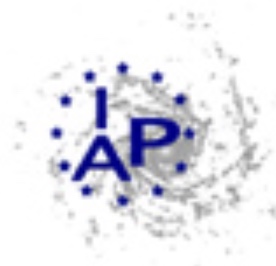


Home Page
People
Events
Primordial Gravitational Waves
Primordial Magnetic Fields
Primordial Black Holes
Observationally, such PBH could constitute all or part of the dark matter (5) (6) in the present-day universe. The part of the PBH mass distribution in 0.1M☉-1M☉ mass range is detectable as massive compact halo (MACHO) objects (7) (8) (9) (3). They could also serve as seeds for supermassive black holes observed in galactic centers, thus resolving the problem of observations "too massive" black holes in high-redshift quasars (10) (11) (12). Finally, it is possible that this type of black holes is directly detected as so-called intermediate mass black holes (IMBH) which are presumably observed in globular clusters based on dynamical measurement (13) (14) and possibly through the X-ray emission in "ultra-luminous" X-ray sources (15) (16). The conjecture that the IMBF in globular clusters are of primordial origin is consistent with generic expectation from model of Ref. (2), see (17) (18). The interest to the PBH research was revived recently due to the exciting possibility that the black holes observed through their mergers in GW events (19) might possibly be of primordial origin (17) (20) (21) (22), see e.g. the reviews (23) (24). Apart from being directly involved into the observed GW merger events, presently it is not even excluded that such PBH make all or a noticeable fraction of the cosmological dark matter.
The specific of the PBH production mechanism suggested in Ref. (2) is that the black hole production starts at the moment of cosmological QCD phase transition when massive nucleons appear. This moment defines a natural mass scale for PBH: the mass within cosmological horizon at the QCD phase transition, which is about the solar mass (2) (25). The peculiarity of the mechanism considered in (2) is that the black hole production is related to the baryogenesis scenario. In such situation, the black holes are formed by regions with large baryonic number (positive or negative). As a byproduct, the mechanism considered in Ref. (2) may lead to abundant compact stellar mass antimatter objects in the universe (formed by density fluctuations which did not collapse directly to black holes) (9) (26) (27).
References:
(1) Y.B.Zeldovich, I.Novikov, Soviet Astronomy 10, 602 (1966).
(2) A. Dolgov, J. Silk, Phys.Rev. D47 3144 (1993).
(3) A.D.Dolgov, M. Kawasaki, N. Kevlishvili, Nucl.Phys. B807 229 (2009) .
(4) I.Affleck, M.Dine, Nucl. Phys. B249, 361 (1985).
(5) J.R.Espinosa, D.Racco, A.Riotto, Phys.Rev.Lett. 120, 121301 (2018).
(6) B.Lacki, J.Beacom, Ap.J. 720, L67 (2010).
(7) Alcock A., et al, Astrophys. J., 542, 281 (2000).
(8) D.P.Bennett, Ap.J. 633, 906 (2005).
(9) S.I.Blinnikov, A.D.Dolgov, K.A.Postnov, Phys. Rev., D92, 023516 (2015).
(10) D.J.Mortlock, et al, Nature 474, 616 (2011).
(11) X.-B.Wu et al, Nature 518, 512 (2015).
(12) E.Banados et al. Nature, 553, 473 (2018).
(13) B.Kiziltan, H.Baumgardt, A.Loeb, Nature, 542, 203 (2017).
(14) B.B.P.Perera, et al., MNRAS 468, 2114 (2017).
(15) T.M.Maccarone, A.Kundu, E.E.Zepf, K.L.Rhode, Nature, 445, 183 (2007).
(16) A.Patruno, S.Portegies Zwart, J.Dewi, C.Hopman, MNRAS, 370, L6 (2006).
(17) S.I.Blinnikov, A.D.Dolgov, N.K.Poryako, K.Postnov, JCAP, 11, 036 (2016).
(18) A. Dolgov, K. Postnov, JCAP 1704, 036 (2017).
(19) B.P.Abbott, et al., Phys.Rev.Lett., 116, 061102 (2016).
(20) S.Bird, I.Cholis, et al., Phys.Rev.Lett., 116, 201301 (2016).
(21) S.Cleese, J.Garcia-Bellido, Phys.Dark Univ., 10, 142 (2016).
(22) M.Sasaki, T.Suyama,T.Tanaki, Phys.Rev.Lett., 117, 061101 (2016).
(23) A.D. Dolgov, Usp.Fiz.Nauk 188 121, Phys.Usp. 61 115 (2018).
(24) A.D. Dolgov Int.J.Mod.Phys. A33, No.31, 1844029 (2018).
(25) K.Jedamzik, Phys.Rev. D55, 5871 (1997).
(26) C. Bambi, A. D. Dolgov, Nucl. Phys. B 784, 132 (2007).
(27) A. D. Dolgov, S. I. Blinnikov, Phys. Rev. D 89, 021301(R) (2014).
dates of project April 1 , 2020 - March 31, 2023
Acknowledgments Financial support of this Project was provided in part by - ANR, France - RSF, Russia